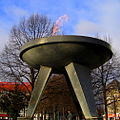Theodor-Heuss-Platz
|
Theo |
|
|---|---|
| Place in Berlin | |
 Theodor-Heuss-Platz seen from the Deutschlandhaus |
|
| Basic data | |
| place | Berlin |
| District | West end |
| Created | 1904 |
| Hist. Names |
Reichskanzlerplatz (1904–1933, 1947–1963) , Adolf-Hitler-Platz (1933–1947) |
| Confluent streets |
Kaiserdamm , Lindenallee, Ahornallee, Pommernallee, Reichsstraße , Heerstraße , Masurenallee |
| Buildings | Deutschlandhaus, television center of the RBB |
| use | |
| User groups | Pedestrians , cyclists , road traffic , public transport |
The Theodor-Heuss-Platz (by residents Theo called) is a public square in Berlin district Westend the district Charlottenburg-Wilmersdorf . It is named after Germany's first Federal President . The Theodor-Heuss-Platz underground station is located under the square .
history


The square was laid out from 1904 to 1908 as part of the Neu-Westend development and was named Reichskanzlerplatz . At first the square was still undeveloped, next to the then newly built underground station there was only the Villa Tanneck , built around 1890 in the style of a fairytale castle, at the northeast end . Until the First World War it was used as a boarding school for girls.
On April 21, 1933, the square was renamed Adolf-Hitler-Platz . When Hitler and his master builder Albert Speer planned to convert Berlin into a “ world capital Germania ”, the square was intended as the west end of the east-west axis . The monumental buildings planned for the square, including a monument by Benito Mussolini , were never completed. A renaming to Mussoliniplatz was also planned. A more central projected square near the Reichstag building should be named after Hitler for this. On July 31, 1947, it got its original name back, Reichskanzlerplatz . Six days after the death of Theodor Heuss , the first German Federal President , the square was given its current name on December 18, 1963.
location
Via Kaiserdamm , Bismarckstrasse and Strasse des 17. Juni , Theodor-Heuss-Platz is connected in a direct line to Ernst-Reuter-Platz , the Victory Column , the Brandenburg Gate and Unter den Linden . The axis is continued in a straight line towards the west through Heerstraße .
building
Striking buildings are the America House on the southern edge of the square , built between 1928 and 1930 to designs by Heinrich Straumer , the architect of the nearby Berlin radio tower , in the New Objectivity style . The Amerikahaus facing Heerstraße was used as a building by the British occupying forces under the name Summit House after the Second World War . Today it houses the cabaret Die Wühlmäuse and a branch of the Federal Ministry of the Interior, for Building and Home Affairs . The studios of the television station Paul Nipkow had been housed in the America House since 1937 .
In 1970, the 18-storey television center on the eastern edge of the square was completed and the Sender Freie Berlin (SFB) moved into it. The successor to the SFB has been the Rundfunk Berlin-Brandenburg (RBB) since May 1, 2003 . In the immediate vicinity of the square is the House of Broadcasting, built in 1930 . It is the headquarters of the RBB. The Berlin exhibition center is directly opposite .
Monuments and works of art
The Eternal Flame burns on Theodor-Heuss-Platz as a memorial for the victims of flight and displacement. The culture committee of the German Bundestag recommended that the preservation of the monument erected in 1955 (at that time initiated by the country teams of the German homeland sales force) be seen as a national task. The flame is maintained and financed by Gasag . In July 2019, damage to the lines was found; To carry out the repairs, the flame was extinguished, but should be back in operation by the day of the homeland on August 31st. On this day, the traditional wreath-laying ceremony takes place at the memorial.
The fountain sculpture Blauer Obelisk by the Berlin artist Hella Santarossa has also stood on Theodor-Heuss-Platz since 1995 .
On the eastern edge of the square, across from the confluence with Masurenallee , the two sculptures ensemble Two Heads by the sculptor Rainer Kriester was set up in 1989 . It consists of the white sculpture Big Tied Head and its black counterpart Big Berlin Head Sign .
Web links
-
Theodor-Heuss-Platz. In: Street name lexicon of the Luisenstädtischer Bildungsverein (near Kaupert )
- Reichskanzlerplatz . In: Luise.
- District lexicon at berlin.de:
- Resolution recommendation of the culture committee on the memorial for the victims of flight and displacement ( memento from April 23, 2007 in the Internet Archive )
Individual evidence
- ↑ Eternal flame on Theodor-Heuss-Platz extinguished , Eternal flame extinguished . In: Berliner Zeitung , July 18, 2019, p. 10 (Berlin page).
Coordinates: 52 ° 30 ′ 34 ″ N , 13 ° 16 ′ 22 ″ E





